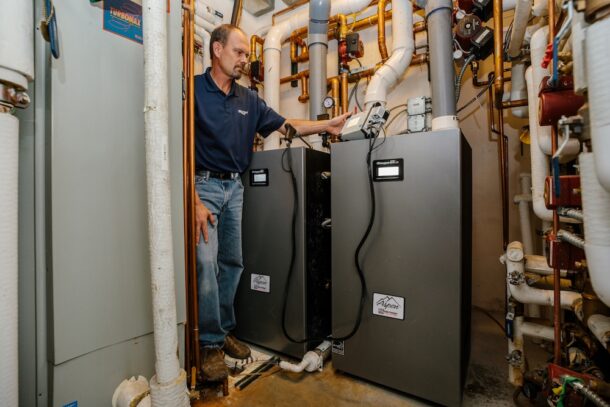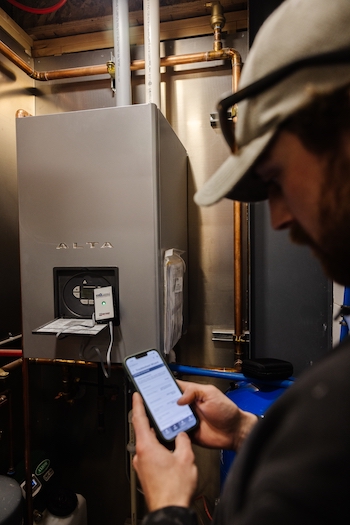Yes! (If the boiler does it for you)
Of all the commodities available to us, time is the most precious. As humans have done for eons, we all trade in the commodity of time. Successful contractors regularly step back to assess whether they are getting the most out of the hours they’ve bartered.
This is where the team at U.S. Boiler Company was determined to add value with the high efficiency Alta boiler. Innovation at U.S. Boiler goes beyond durability and performance to saving your most precious resource: a skilled tradesperson’s time.

Gas analyzers should always make their way to the jobsite.
What are the most time-consuming and painful steps of installing or servicing a boiler? The Alta boiler addresses several steps near the top of your list, but it doesn’t just make them easier. You can skip them. Let’s start with combustion setup.
First, we can all agree that combustion setup takes time, and that improper setup can lead to big problems. What are the biggest challenges with combustion set up?
Ambient Temperature
If you have a passion for all things measured in horsepower, you know that your car, boat, motorcycle, etc. runs best on cool fall nights. This is because the cooler air is denser. That is, it contains more oxygen per cubic foot. The more oxygen in the cylinder, the more power generated.

Contractor conducts setup of the Alta boiler by U.S. Boiler using the USB-Connect phone app.
With boilers, we face a similar dynamic. Most of us perform preventative maintenance during the summer months. At this time of year, air temps can range from 50°F to 100°F or more, depending on your location.
Once winter rolls around and the outdoor temps drop, those combustion targets we worked so hard to achieve go right out the window. The dense air will skew your combustion to the leaner side of the spectrum (not enough fuel for the oxygen present) because your calibration was conducted when the ambient temperature was higher.
The problem gets worse if the combustion check was skipped altogether. If the boiler is already too lean, you might be required to pay a free visit to the site during the colder months and encounter the homeowner sporting what is colloquially known in the industry as “lemon face” due to a no heat call.
Well … It’s Complicated
Technicians face the daunting task of working on a wide variety of equipment and trying to keep pace with industry advancements. When setting the combustion on most high efficiency boilers, proper setup requires tuning at both high and low fire. This means knowing which screw to adjust, how to lock the boiler in high and low fire, and hoping the system has enough capacity to dissipate the heat generated during testing to keep the boiler running. That’s a lot to expect of a seasoned tech, much less some of the newer faces joining our industry.
What Analyzer?
Like fishing, combustion testing is frequently accompanied by “far away eyes and bold-faced lies.” I’m constantly amazed by the number of technicians who share the following comments with such a level of innocence, sincerity and/or ignorance that I’m not always sure how to respond.
- “We don’t have an analyzer. Never have! Boss says we don’t need one.”
- “We don’t have an analyzer. Boss keeps it in the office…”
- “We have an analyzer, but the last time it was calibrated was during the Nixon administration…”
- “We have an analyzer, but it doesn’t work. Ever since we left it in the truck last winter the numbers are all wonky.”
- “We have an analyzer, but I’m not trained on it.”
These are just a small sample of the excuses I’ve heard. There are many, many more, some of which deserve an A+ for creativity. Long story short, there’s cause for concern on whether the boiler was set up correctly, if at all. Which brings us to the Alta.
Alta Does It for You
The gas train in the Alta boiler utilizes an adaptive combustion system. Unlike a simple pneumatic gas train, gas adaptive technology uses the flame signal to constantly tune combustion. What does this mean to homeowners, contractors, and technicians?
Everyone is familiar with the K.I.S.S. concept. We use it in a slightly different manner for the Alta. Keep It Sweet and Simple!
Sweet—Alta’s adaptive system constantly tunes burner combustion, keeping the boiler consistently in the sweet spot, maintaining the cleanest heat exchanger possible while achieving optimal efficiency.
Simple—Because the Alta adaptive combustion system uses basic components and a time-tested method of monitoring, the Alta solution is elegant and ingenious, without being complex. No more worries about changing combustion air temperatures or watching over techs as they adjust combustion.
Alta does the heavy lifting for you by tuning itself to site conditions. The boiler runs its own combustion setup, so you don’t have to.
Technology should not replace knowledge of hydronic systems, but it should make your life easier. You should own and be competent in the use of a combustion analyzer so you can be sure there are no installer-induced failures like reversed low profile termination fittings (it’s happened) or wads of insulation that inadvertently get lodged in the combustion air piping (yep, this happened too!), or cross contamination at the vent termination (the list goes on).
Adaptive combustion delivers faster installations and fewer callbacks on combustion issues. That’s how you do more with the time you have. So go ahead, skip combustion setup with Alta.
Tom Secondino is a Technical Sales Support Specialist for U.S. Boiler Company, a manufacturer of residential and commercial heating products, including condensing, non-condensing and electric boilers. For more information on the Alta boiler, visit our Alta Product Page



